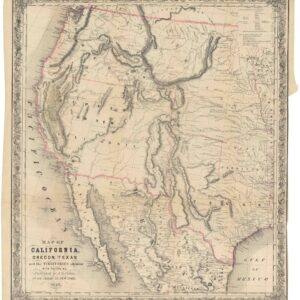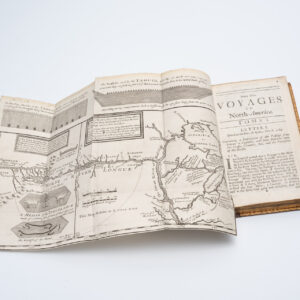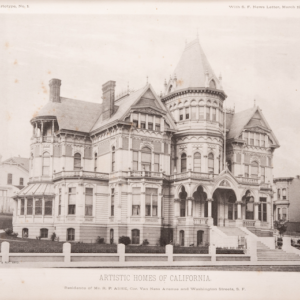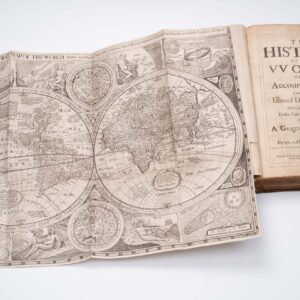A fantastic composite atlas from the apex of the Dutch Golden Age of cartography focused on the emergent Republic of the United Netherlands.
[Ortelius & Hogenberg Atlas Factice]
$39,500
In stock
Description
This is a unique Atlas Factice from the contentious late 16th century. Its compiler arranged the atlas in a slim and tall format such that each map is double-folded to fit inside the tome. This rare and unusual format was likely designed to make the atlas more compact and easier to carry. Whatever the purpose, there can be little doubt: this was a collation of some of the finest maps at the time.
Consisting of maps from different sources, this atlas was created around 1600, presumably at the behest of a Dutch or Flemish nobleman. Bound in vellum, the binding was embossed with the owner’s crest, underscoring how such atlases were the prerogative of the most privileged in society. The atlas focuses on western Europe, with the Low Countries and surrounding regions represented in particular detail. The individual sheets all consist of double-page engraved folio maps from other seminal works of cartography. The maps have wide margins, and most remain blank on the verso.
This atlas is, first and foremost, a unique cartographic artifact. Several sheets merit specific attention. The rarest map is Frans Hogenberg’s Germaniae Inferioris Omnium Accuratissima Delineatio (1578). It is one of history’s oldest printed charts of the Netherlands (only ten known institutional examples) and retains original coloring in subtle bluish-green tones.
Another scarce map is the third chart in the volume: Michael Eytzinger and Frans Hogenberg’s zoomorphic map of the Low Countries in the shape of a ‘rampant lion,’ a common heraldic symbol for bravery, values, strength, and royalty. Known as the Leo Belgicus, this map was issued from Hogenberg’s workshop in Cologne in 1588. This example is the second state of this iconic map. Eytzinger originally conceptualized the Low Countries in this manner (1583), making it one of the earliest examples of an explicitly political map.
The first map in the atlas is a world map that is generally acknowledged as one of the significant milestones in the history of cartography. Typus Orbis Terrarum was published in the original edition of Abraham Ortelius’ iconic atlas Theatrum Orbis Terrarum (1570). This example is a rare first state, identified by the riveted repair in the lower left corner of the plate. Again, the map has nice original coloring. While issued in Ortelius’ atlas, the engraver behind this chart was Frans Hogenberg. In general, the maps included in this composite atlas derive almost exclusively from the work of these two cartographic pioneers.
Context is everything
In 1549, the Dutch and Flemish fiefs fell under Philip II of Spain, who consolidated power to exercise direct rule, which included a harsh countenance of Calvinist sentiments. This led to the outbreak of the Eighty Years’ War in 1568, and in January 1579, the seven northern provinces declared independence from Spain and formed the first Dutch republic.
After Philip died in 1598, there came a long period of stability and economic growth during which art and science flourished. This is the setting in which our atlas was created: shortly after tensions and conflict had abated and a more stable and prosperous period had been initiated. The question is: who commissioned this atlas and why?
Our best guess is that the patron of this atlas would have been a nobleman from the Low Countries themselves. The mapmakers used are exclusively from this region, with Hogenberg only working out of Cologne for fear of the Spanish Inquisition. The atlas was most likely compiled in the wake of the difficult first years of the Republic of the Seven United Netherlands. During this tumultuous period, the Dutch nobility managed to maintain power by organizing into knighthoods that represented each family on the provincial council of the Dutch Republic (a.k.a. the States-Provincial). Identifying the crest on the cover might reveal precisely such a council member as the patron.
Complete list of maps:
Cartographer(s):
Abraham Ortelius (1527-1598) was born in Antwerp to Flemish parents in 1527. After studying Greek, Latin, and mathematics, he and his sister set up shop as book dealers and a ‘painter of maps.’ In his heart, Ortelius was, nevertheless, first and foremost a historian. He believed geography was the ‘eye of history,’ which explains why he collected maps and historical documents with such passion. Ortelius traveled widely in pursuit of his interests, building contacts with mapmakers and literati all over the European continent.
Ortelius reached a turning point in his career in 1564 with the publication of a World Map in eight sheets, of which only a single copy survives. In 1570, he published a comprehensive collection of maps titled Theatrum orbis terrarum (Theatre of the World). The Theatrum is conventionally considered the first modern-style atlas. It was compiled by collecting maps and charts from colleagues across the continent, which Ortelius then had engraved in a uniform size and style. The engraver for most of the maps in Theatrum was none other than the famous Frans Hogenberg, who also served as the main engraver for the 16th-century urban atlas Civitates Orbis Terrarum, published with Georg Braun in 1572.
Hogenberg’s re-drawn and standardized maps formed the basis of the first atlas in history (even though it was Mercator who was the first to use the term a few decades later). Unlike many of his contemporaries, Ortelius noted his sources openly and in the first edition, acknowledged no less than eighty-seven different European cartographers. This ‘catalogus auctorum tabularum geographicum‘ is one of the major innovations of his atlas. The list of contributing mapmakers was kept up-to-date for decades after Ortelius’ death. In the first edition of 1570, this list included 87 names, whereas the posthumous edition of 1603 contained no less than 183 names.
While compiled by Abraham Ortelius in the manner described above, the Theatrum was first printed by Gielis Coppens van Diest, an Antwerp printer experienced with cosmographical books. Van Diest was succeeded by his son Anthonis in 1573, who in turn was followed by Gillis van den Rade, who printed the 1575 edition of Ortelius’ atlas. From 1579, Christoffel Plantin took over, and his successors continued to print Theatrum until Ortelius’ heirs sold the copperplates and the publication rights to Jan Baptist Vrients in 1601. In 1612, shortly after Vrients’s death, the copperplates passed to the Moretus brothers.
Frans HogenbergFrans Hogenberg (1535–1590) was a Flemish painter, engraver, and mapmaker.
Condition Description
Seventeen folded double-page engraved maps; wide margined with blank versos; repairs to wing folds with vellum tabs and old paper. Contemporary vellum, stained but sound, faded crest to upper cover.
References



